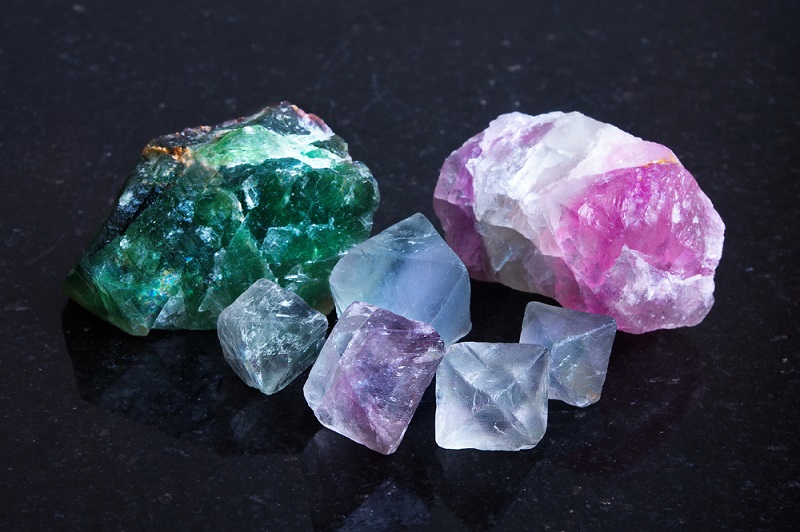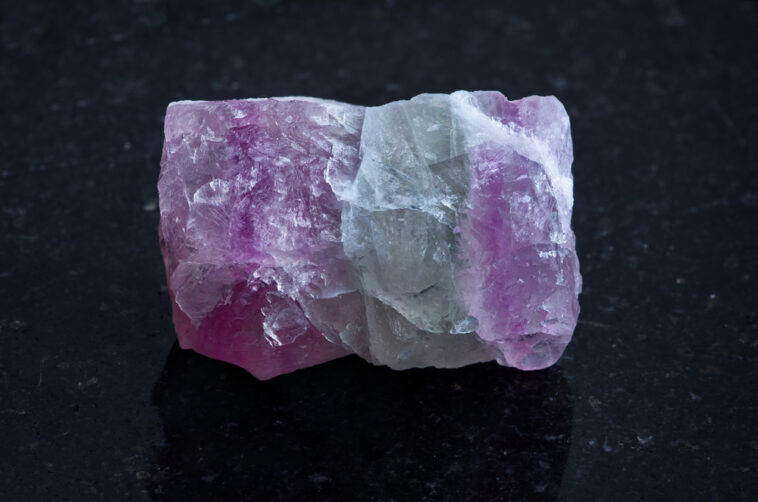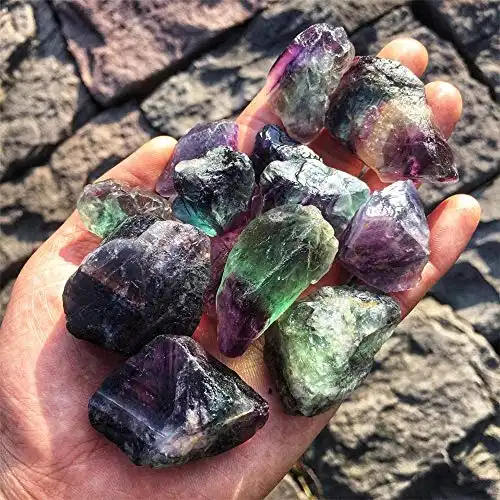Fluorite is one of the most popular stones among collectors due to its enormous range of colors. It is often called the most colorful mineral in the world. Deep blue, vivid purple, sunny yellow, crystal clear, and rainbow – such a great variety of colors. Violet or purple is the classic and most common fluorite color, while blue and yellow fluorite is very rare.
If you are interested in this mineral, and you want to know more about it, this article is for you. Keep reading to learn more about it, including where you can find it and how to look for it.
Read More: Fluorite vs Fluoride (Are They Related?)
What Is Fluorite?

Fluorite (also known as fluorspar) is a gangue mineral that belongs to the halide minerals. Commercially, it is named fluorspar and is composed of calcium fluoride (CaF2).
It is used industrially in the manufacturing of certain enamels, glass, and some optical lenses and as smelting flux.
Even though pure fluorite is colorless, it is often colored due to the presence of various impurities. The most common colors are purple, pink, white, brown, green, magenta, and red.
Types of Fluorite
There are different types of fluorite, and here is a list of some commonly used names for fluorite varieties:
Raw Fluorite
It is also often referred to as rough fluorite. These stones are characterized by asymmetrical shapes and rough edges as they are not perfectly polished and do not look aesthetically appealing.
This type of fluorite is perfect for home use, while polished fluorite minerals are more comfortable and direct contact with the body.
Tumbled Fluorite
Tumbling is the process of polishing and smoothing rocks and minerals. During this process, minerals are placed in a special machine that rolls them around until all rough and sharp edges are erased.
Tumbled fluorite stones feel comfortable in the palm of the hand, which makes them perfect for close contact work and mediation.
Banded Fluorite
Banded fluorite stones are characterized by a combination of multiple colors. The colors may exhibit themselves in various bands or stripes throughout the mineral. A great example of the banded type is rainbow fluorite.
Alien Eye Fluorite
This type of fluorite is one of the rarest and most unique that is not easy to find. The center of this mineral is vivid green and it can form a perfect cube.
A jet black color surrounds the cube and works great with the diamond/cube in the center. The center of alien eye fluorite is sometimes called octahedral fluorite.
It is also believed this type of fluorite brings you luck, especially if you can find it in the first place.
Phantom Fluorite
It is another very rare and unique type of fluorite. It is often called a “negative crystal”, with regards to how this mineral is formed.
It is characterized by a distinct cube in the middle that is surrounded by either colored or clear fluorite.
Chinese Fluorite
One of the largest world’s supplies of fluorite comes from China. Fluorite is so common in China that there are reported cases of people supposedly being poisoned by the mineral.
Botryoidal Fluorite
It is a lilac-colored mineral with a very soft, bubble-like structure that makes fluorite look like cotton candy. It is often formed in geodes, which is not typical for fluorite in general.
Faceted Fluorite
It is a type of fluorite that has been cut and shaped into structured gems. Faceted fluorite stones are characterized by multi-faceted surfaces, which is similar to stones on the crown jewels.
Where Can I Find Fluorite?
You can find fluorite worldwide. The largest amounts of this mineral are in Russia, England, China, Morocco, Switzerland, South Africa, Namibia, Mexico, Canada, India, Spain, and the United States. A blue variety of fluorite is found exclusively in England.
In the United States, fluorite is mainly found in Kentucky, Illinois, Missouri, and Colorado. Also, it is interesting to note that fluorite is actually considered Illinois’ state mineral, and it has been mined in Southeastern Illinois since the early 1800s. It is a fluorspar-rich region and is called Illinois-Kentucky Fluorspar Mining District.
The biggest deposits of fluorite in North America are in the Burin Peninsula, Canada. The first recognition of this mineral in that area was recorded in 1843 by geologist J.B. Jukes. However, the commercial mining of fluorite in the region began only in 1928.
What Is Fluorite Used For?
In the United States, Native Americans used carved fluorspar to produce artifacts. However, in 1823, there was the first record when fluorite was used to manufacture hydrofluoric acid.
Today, fluorite is vital to the nation’s economy, and its uses are the following:
- Manufacture of glass, ceramics, portland cement, smelting iron, aluminum, and other metal alloys.
- Hydrofluoric acid, including refining aluminum and refining uranium for nuclear reactors.
- Inorganic fluoride chemicals. They include concrete hardeners, optical lenses, special fluxes for welding rods, and toothpastes
- Organic fluoride chemicals, such as refrigerants, lubricants, nonstick coatings, medicines and anesthetics, stain repellents, herbicides, and dyes.
Is There Fake Fluorite?
Unfortunately, fake fluorite minerals are a very common problem today, and there are many counterfeit crystal factories in the world. It is also important to note that most fake fluorite comes from China.
Therefore, you should be always vigilant and buy fluorite from reputable sources. It is better to buy from retailers who have reviews from their past customers.
Real vs. Fake Fluorite
Here is a list of six main differences between real fluorite and a fake one.
- Transparency. Real fluorite can be either transparent or semi-transparent, while a fake one is usually a solid opaque.
- Oil treatment. Treatment of real fluorite is rarely observed in order to increase luster and transparency.
- Hardness test. Real fluorite is soft, and it can be easily scratched by a knife or glass. Fake fluorite made of glass is hard to scratch.
- Weight. Real fluorite weighs more due to its high specific gravity. As opposite, fake fluorite does not weigh a lot.
- Ultraviolet light test. Real fluorite minerals will glow either white or blue, regardless of the color they were before, while fake fluorite does not glow at all.
- Form of occurrence. Real fluorite is an isometric crystal in octahedrons or cubic form, while most fake fluorite stones occur in tumbling.
Is Real Fluorite Expensive?
The cost of fluorite crystal depends on several factors, including color, clarity, size, and cut.
There are some fluorite stones that are quite expensive, but most of them are affordably priced and can be purchased from small-scale and large-scale merchants around the world.
Where To Buy Fluorite?
Since real fluorite is quite a common mineral, it is safe to purchase it everywhere, especially if fluorite is suggested in its natural form of occurrences, such as octahedron or cubic.
The best and most reliable place to purchase fluorite is one of the local mines, where fluorite is extracted. Often, small mining firms sell the best fluorite stones that they have found.
- Online rock and mineral club for collectors of all levels!
- Find community with like-minded rock and mineral enthusiasts.
- Monthly Giveaways!
- Free Access to Entire Digital Library of Products (current and future products)*




